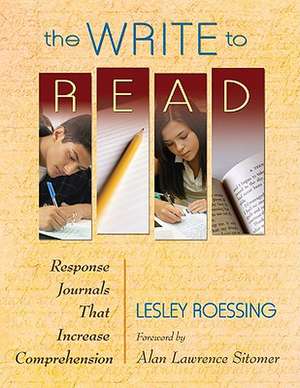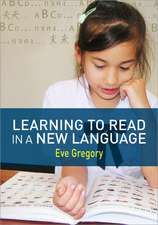The Write to Read: Response Journals That Increase Comprehension
Editat de Lesley J. Roessingen Limba Engleză Paperback – 7 oct 2009
Preț: 301.26 lei
Nou
Puncte Express: 452
Preț estimativ în valută:
57.65€ • 60.46$ • 47.99£
57.65€ • 60.46$ • 47.99£
Carte tipărită la comandă
Livrare economică 01-15 aprilie
Preluare comenzi: 021 569.72.76
Specificații
ISBN-13: 9781412974264
ISBN-10: 1412974267
Pagini: 200
Dimensiuni: 216 x 279 x 15 mm
Greutate: 0.57 kg
Ediția:1
Editura: SAGE Publications
Colecția Corwin
Locul publicării:Thousand Oaks, United States
ISBN-10: 1412974267
Pagini: 200
Dimensiuni: 216 x 279 x 15 mm
Greutate: 0.57 kg
Ediția:1
Editura: SAGE Publications
Colecția Corwin
Locul publicării:Thousand Oaks, United States
Recenzii
"A transactional approach to understanding literature will come alive for intermediate and middle school teachers and students who avail themselves of Roessing's advice and examples in this book. What a practical resource for teachers! Facilitating a balanced reading and writing program is at the heart of The Write to Read."
"This is such an easy answer: a curriculum that builds to strong reader response. This is a gem."
"A comprehensive, well-reasoned text devoted to reader response at middle elementary and secondary levels. Such authenticity is appealing to the field."
"The major strengths of the book are the explicit instructions for set-up, multiple examples of student responses, examples of varieties of texts used for modeling, and materials for teacher use in appendices."
"The author provides very engaging and helpful examples throughout the book. One can really 'see' how these ideas work."
"This is such an easy answer: a curriculum that builds to strong reader response. This is a gem."
"A comprehensive, well-reasoned text devoted to reader response at middle elementary and secondary levels. Such authenticity is appealing to the field."
"The major strengths of the book are the explicit instructions for set-up, multiple examples of student responses, examples of varieties of texts used for modeling, and materials for teacher use in appendices."
"The author provides very engaging and helpful examples throughout the book. One can really 'see' how these ideas work."
Cuprins
List of Figures
List of Photographs
Foreword
Preface
Acknowledgments
About the Author
1. The Three Rs: Rationale for Reader Response
Part I Before-Reading Response
2. The Pre-Reading Response
How to Choose a Book
The Anticipation Response
Adaptations
PART II During-Reading Response
3. Journaling: Setup for Success
Reading Experiences in My Classroom
The Reading Journal
Teaching During-Reading Response
Avoiding Retelling: Response Starters
Independent Reading Response
Abandonment Response
Adaptations
4. Double-Entry Journaling and Sticky Notes
Double-Entry Journaling
Strategy Response
Putting It All Together
Going Deeper: Using Sticky Notes
Adaptations
5. Poetic Response
Found Poetry
Narrative Poetry
Poems in Two Voices
I Am...Poetry
The Advantages of Poetry
6. Interactive Response
Note Passing
Family Letters
Letters to Friends
Co-Reading Letters
Talking About Texts
Collaborative Response
7. Literature Circles and Book Clubs: Discussion Response
Literature Circles as Training
Book Clubs
Book Club Response
Adaptations
8. Individual Reading: Relinquishing Control and Giving Choice
Reading Like a Writer: Writer's Craft Responses
Choice Reading - Choice Response
Multigenre Response
Drawing as Response
Reaching the Goal: Unique, Varied, Personal, Individual Response
A Sample Journal for One Novel
Adaptations
The Case of Julio, ELL Student
Part III After-Reading Response
9. Post-Reading Response
Text Reformulations
The Post-Reading Evaluative Responses
Book Reviews and Book Talks
Book Reviews
Book Talks
Literary Critiques
Adaptations
Part IV Content Area Response Adaptations
10. Responding Across the Curriculum
Nonfiction Texts
Text Features
Marginal Notes
Electronic Media - Web Site Response
Content Area Reading
Pre-Reading Response
During-Reading Response
Journaling
Double-Entry Journals
Poetic Response
Note Passing
After-Reading Response
The Rationale
Part V Response Evaluation
11. Teacher and Student Evaluation
Formative Assessments
Assessment of Independent Reading
The Assessment Process
Evaluative Assessments: Grading
Assessment of Shared Reading
Rationale
"What's in It for Me?" Student Metacognition and Musings
First Marking Period Self-Analysis
After a Semester of Response
End-of-Year Reflection
12. Coming to a Conclusion
Resource A: Literary References
Resource B: Forms and Examples
1. Independent Reading Requirements (Chapter 3)
2. Daily Reading Log (Chapter 3)
3. Literature Response Starters (Chapter 3)
4. Reading Interests/Books Pass Charts (Chapter 3)
5. Double-Entry Journal - Questioning (Chapter 4)
6. Question-Answer Chart (Chapter 4)
7. Strategies Used by Successful Readers (Chapter 4)
8. Double-Entry Journal - Making Connections (Chapter 4)
9. Double-Entry Journal - Literary Elements (Chapter 4)
10. Double-Entry Journal - Identifying Strategies Used (Chapter 4)
11. Sticky-Note Response Journal (Chapter 4)
12. Sticky-Note Question-Anwer-Response Journal (Chapter 4)
13. Book Club Meeting Agenda (Chapter 7)
14. Book Club Double-Entry Response Journal (Chapter 7)
15. Reading Strategies - Author's Craft Journal (Chapter 8)
16. Author's Craft Response Journal (Chapter 8)
17. News Article Formats (Chapter 9)
18. Content Area Double-Entry Response Journal (Chapter 10)
References
Credits
Index
List of Photographs
Foreword
Preface
Acknowledgments
About the Author
1. The Three Rs: Rationale for Reader Response
Part I Before-Reading Response
2. The Pre-Reading Response
How to Choose a Book
The Anticipation Response
Adaptations
PART II During-Reading Response
3. Journaling: Setup for Success
Reading Experiences in My Classroom
The Reading Journal
Teaching During-Reading Response
Avoiding Retelling: Response Starters
Independent Reading Response
Abandonment Response
Adaptations
4. Double-Entry Journaling and Sticky Notes
Double-Entry Journaling
Strategy Response
Putting It All Together
Going Deeper: Using Sticky Notes
Adaptations
5. Poetic Response
Found Poetry
Narrative Poetry
Poems in Two Voices
I Am...Poetry
The Advantages of Poetry
6. Interactive Response
Note Passing
Family Letters
Letters to Friends
Co-Reading Letters
Talking About Texts
Collaborative Response
7. Literature Circles and Book Clubs: Discussion Response
Literature Circles as Training
Book Clubs
Book Club Response
Adaptations
8. Individual Reading: Relinquishing Control and Giving Choice
Reading Like a Writer: Writer's Craft Responses
Choice Reading - Choice Response
Multigenre Response
Drawing as Response
Reaching the Goal: Unique, Varied, Personal, Individual Response
A Sample Journal for One Novel
Adaptations
The Case of Julio, ELL Student
Part III After-Reading Response
9. Post-Reading Response
Text Reformulations
The Post-Reading Evaluative Responses
Book Reviews and Book Talks
Book Reviews
Book Talks
Literary Critiques
Adaptations
Part IV Content Area Response Adaptations
10. Responding Across the Curriculum
Nonfiction Texts
Text Features
Marginal Notes
Electronic Media - Web Site Response
Content Area Reading
Pre-Reading Response
During-Reading Response
Journaling
Double-Entry Journals
Poetic Response
Note Passing
After-Reading Response
The Rationale
Part V Response Evaluation
11. Teacher and Student Evaluation
Formative Assessments
Assessment of Independent Reading
The Assessment Process
Evaluative Assessments: Grading
Assessment of Shared Reading
Rationale
"What's in It for Me?" Student Metacognition and Musings
First Marking Period Self-Analysis
After a Semester of Response
End-of-Year Reflection
12. Coming to a Conclusion
Resource A: Literary References
Resource B: Forms and Examples
1. Independent Reading Requirements (Chapter 3)
2. Daily Reading Log (Chapter 3)
3. Literature Response Starters (Chapter 3)
4. Reading Interests/Books Pass Charts (Chapter 3)
5. Double-Entry Journal - Questioning (Chapter 4)
6. Question-Answer Chart (Chapter 4)
7. Strategies Used by Successful Readers (Chapter 4)
8. Double-Entry Journal - Making Connections (Chapter 4)
9. Double-Entry Journal - Literary Elements (Chapter 4)
10. Double-Entry Journal - Identifying Strategies Used (Chapter 4)
11. Sticky-Note Response Journal (Chapter 4)
12. Sticky-Note Question-Anwer-Response Journal (Chapter 4)
13. Book Club Meeting Agenda (Chapter 7)
14. Book Club Double-Entry Response Journal (Chapter 7)
15. Reading Strategies - Author's Craft Journal (Chapter 8)
16. Author's Craft Response Journal (Chapter 8)
17. News Article Formats (Chapter 9)
18. Content Area Double-Entry Response Journal (Chapter 10)
References
Credits
Index
Descriere
Developed for secondary school teaching, this guide focuses on building reading comprehension skills through journal writing and provides a yearlong, scaffolded curriculum with classroom-ready writing exercises.




